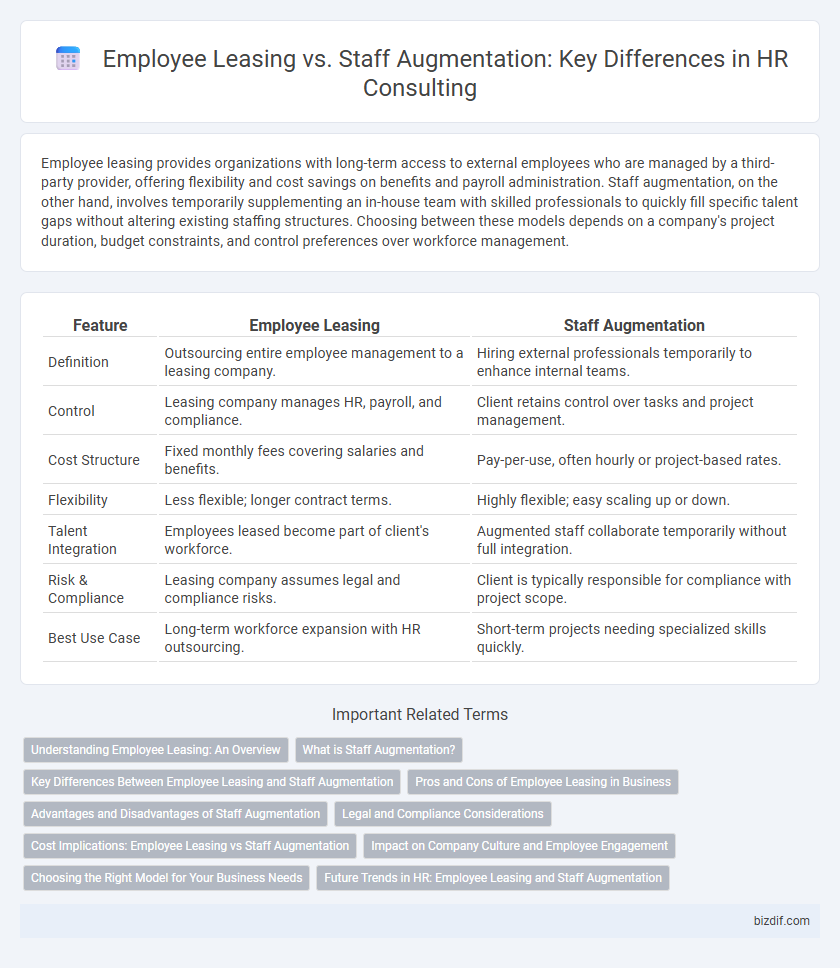Employee leasing provides organizations with long-term access to external employees who are managed by a third-party provider, offering flexibility and cost savings on benefits and payroll administration. Staff augmentation, on the other hand, involves temporarily supplementing an in-house team with skilled professionals to quickly fill specific talent gaps without altering existing staffing structures. Choosing between these models depends on a company's project duration, budget constraints, and control preferences over workforce management.
Table of Comparison
| Feature | Employee Leasing | Staff Augmentation |
|---|---|---|
| Definition | Outsourcing entire employee management to a leasing company. | Hiring external professionals temporarily to enhance internal teams. |
| Control | Leasing company manages HR, payroll, and compliance. | Client retains control over tasks and project management. |
| Cost Structure | Fixed monthly fees covering salaries and benefits. | Pay-per-use, often hourly or project-based rates. |
| Flexibility | Less flexible; longer contract terms. | Highly flexible; easy scaling up or down. |
| Talent Integration | Employees leased become part of client's workforce. | Augmented staff collaborate temporarily without full integration. |
| Risk & Compliance | Leasing company assumes legal and compliance risks. | Client is typically responsible for compliance with project scope. |
| Best Use Case | Long-term workforce expansion with HR outsourcing. | Short-term projects needing specialized skills quickly. |
Understanding Employee Leasing: An Overview
Employee leasing is a strategic HR consulting service where a company outsources payroll, benefits, and compliance management to a professional employer organization (PEO), allowing businesses to focus on core operations while reducing administrative burdens. This model contrasts with staff augmentation, which temporarily increases workforce capacity by integrating external professionals under the company's direct supervision without transferring employer responsibilities. Understanding employee leasing enables organizations to optimize human resource management, mitigate legal risks, and enhance employee benefits administration.
What is Staff Augmentation?
Staff augmentation is a flexible outsourcing strategy that allows companies to temporarily expand their workforce by hiring external professionals with specific skills to address project demands or skill gaps. This approach enhances operational efficiency without the long-term commitment of adding permanent employees, enabling businesses to scale teams quickly in response to fluctuating workloads. HR consulting firms often recommend staff augmentation to optimize talent acquisition while maintaining control over project management and team structure.
Key Differences Between Employee Leasing and Staff Augmentation
Employee leasing involves a third-party provider handling all HR functions, payroll, and compliance for leased employees, offering a comprehensive workforce management solution. Staff augmentation supplements existing teams with specialized talent for short-term projects without altering the company's internal HR responsibilities. Key differences include employer responsibility, duration flexibility, and the scope of HR services provided, impacting cost efficiency and control over workforce management.
Pros and Cons of Employee Leasing in Business
Employee leasing offers businesses the advantage of streamlined payroll, benefits administration, and compliance management, reducing administrative burdens and legal risks. However, it may limit direct control over employees and pose challenges in aligning leased staff with company culture and long-term goals. Companies must weigh the cost-effectiveness and flexibility of employee leasing against potential drawbacks in employee integration and management oversight.
Advantages and Disadvantages of Staff Augmentation
Staff augmentation offers the advantage of flexible scaling of workforce without long-term commitment, enabling businesses to quickly access specialized skills for project-based needs. However, it may lead to challenges in team integration and potential inconsistencies in company culture since augmented staff are typically temporary and less embedded in the organization. This approach can also result in higher costs compared to in-house employees if used extensively over long periods.
Legal and Compliance Considerations
Employee leasing involves a formal agreement where a leasing company assumes responsibility for payroll, benefits, and legal compliance, reducing the client company's risk related to labor laws and tax regulations. In staff augmentation, the client retains responsibility for compliance and employment law adherence, requiring careful oversight to avoid misclassification and liability issues. Understanding jurisdiction-specific labor laws and ensuring clear contractual terms are critical in both models to mitigate legal risks and maintain regulatory compliance.
Cost Implications: Employee Leasing vs Staff Augmentation
Employee leasing typically involves a fixed monthly fee that covers salaries, benefits, and administrative costs, providing predictable budgeting for businesses. Staff augmentation, on the other hand, often incurs variable costs based on hourly rates or project duration, which can lead to higher expenses during peak demand periods. Companies must evaluate these cost structures against their workforce flexibility needs to determine the most cost-effective solution.
Impact on Company Culture and Employee Engagement
Employee leasing often leads to decreased company culture cohesion as leased employees may feel less integrated, impacting overall employee engagement negatively. Staff augmentation allows for greater alignment with existing teams, fostering stronger cultural integration and higher engagement levels. Companies prioritizing sustained culture development benefit more from staff augmentation over employee leasing.
Choosing the Right Model for Your Business Needs
Employee leasing offers a comprehensive outsourcing solution where the leasing company manages payroll, benefits, and compliance, providing your business with dedicated staff without the administrative burden. Staff augmentation allows businesses to quickly scale teams with specialized talent on a flexible basis, maintaining direct control over project management and team integration. Selecting the right model depends on your company's need for control, resource flexibility, and administrative capacity to optimize talent management and operational efficiency.
Future Trends in HR: Employee Leasing and Staff Augmentation
Employee leasing is evolving with integrated AI-driven payroll and benefits management, enhancing compliance and reducing administrative burdens. Staff augmentation increasingly leverages remote work platforms and gig economy models, providing scalable, specialized talent on demand. Future trends indicate a hybrid approach combining employee leasing's stability with staff augmentation's flexibility to optimize workforce agility.
Employee leasing vs staff augmentation Infographic

 bizdif.com
bizdif.com